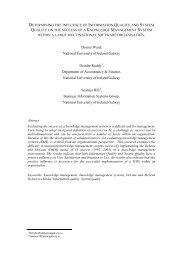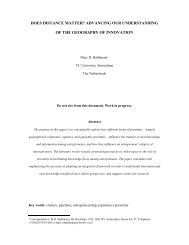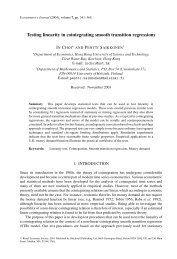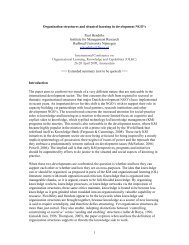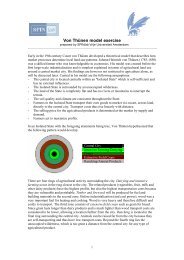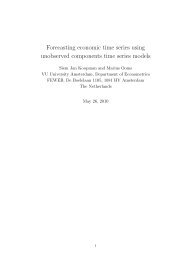The effects of road pricing - Feweb - Vrije Universiteit Amsterdam
The effects of road pricing - Feweb - Vrije Universiteit Amsterdam
The effects of road pricing - Feweb - Vrije Universiteit Amsterdam
You also want an ePaper? Increase the reach of your titles
YUMPU automatically turns print PDFs into web optimized ePapers that Google loves.
first-best <strong>pricing</strong> is increasingly recognised as being <strong>of</strong> limited practical relevance, but<br />
it might serve as a useful theoretical benchmark.<br />
We have seen that various market circumstances and characteristics hinder the<br />
transport market in setting prices based on marginal costs. In addition, various<br />
constraints and barriers may exist that prevent a regulator from determining prices<br />
that it ideally would like. Verhoef (2002) mentions the following important<br />
constraints:<br />
• Technological and practical constraints: first-best <strong>pricing</strong> requires charges that<br />
vary continuously over time, place, route chosen, type <strong>of</strong> vehicle, driving style,<br />
etc, which might be too sophisticated and not understood by drivers or impossible<br />
to implement under available charging technologies;<br />
• Acceptability constraints: there may be too much resistance and uncertainty (e.g.<br />
about the objective and necessity <strong>of</strong> the measure) that it may seem preferable to<br />
start with a few small-scale demonstration projects;<br />
• Institutional constraints: one example is where local or regional governments<br />
cannot affect some transport charges that are set by a higher level government;<br />
• Legal constraints: ideal prices might not be possible on the basis <strong>of</strong> legal<br />
arguments (e.g. when taxes should be predictable);<br />
• Financial constraints: for instance, the prior definition <strong>of</strong> minimum or maximum<br />
tax revenue sums to be collected;<br />
• Market interaction constraints: transport taxes will have many consequences for<br />
other markets, among the most important is the labour market;<br />
• Political constraints: charges may become a political issue much more than an<br />
economic question.<br />
This has led to some discussion on the practical relevance <strong>of</strong> marginal cost <strong>pricing</strong>.<br />
Rothengatter (2003) argues that marginal cost <strong>pricing</strong> is no longer optimal when<br />
aspects such as acceptability and institutional consequences are introduced into the<br />
analysis, and a real-world <strong>pricing</strong> system can therefore not be based on abstract<br />
economic theory. Nash (2003) replies that indeed difficulties and uncertainties remain<br />
(which should be carefully considered), but that there is no need for a totally different<br />
theoretical approach, marginal social costs are the correct starting point in the<br />
development <strong>of</strong> any efficient <strong>pricing</strong> policy.<br />
Given these constraints and discussions, economic research has focused on setting<br />
prices that are available optimally, under the constraints applying: second-best prices.<br />
Examples <strong>of</strong> second-best tolling include the use <strong>of</strong> toll cordons around cities instead<br />
<strong>of</strong> tolling each <strong>road</strong> in the network, and the use <strong>of</strong> step tolls instead <strong>of</strong> smoothly timevarying<br />
tolls. It is safe to state that second-best <strong>pricing</strong> will be the rule for the<br />
implementation <strong>of</strong> marginal cost-based <strong>pricing</strong> in reality.<br />
2.5.1 Second-best <strong>pricing</strong>: an overview <strong>of</strong> some results<br />
It is clear that some aspects <strong>of</strong> the transport sector do not correspond to first-best<br />
conditions. We then enter the world <strong>of</strong> second-best, where the imperfectness <strong>of</strong> one<br />
variable has consequences for the optimal value <strong>of</strong> others. <strong>The</strong> conclusions that<br />
emerge from second-best analyses are dependent on the details <strong>of</strong> the situation under<br />
consideration, and it is hard to draw general conclusions. A substantial technical<br />
literature has emerged over the last decade that addresses various types <strong>of</strong> second-best<br />
<strong>pricing</strong> schemes (i.e. what do the tax rules look like, how do they deviate from<br />
Pigouvian charges), and analyses the relative efficiency <strong>of</strong> these schemes. Attention<br />
has turned in the recent literature to more realistic types <strong>of</strong> ‘second-best’ <strong>pricing</strong>, in<br />
26





